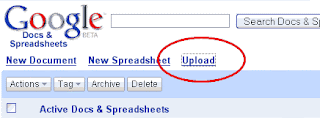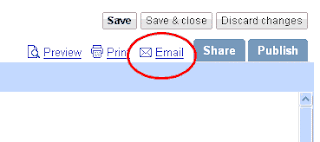Most people know by now that you can read, write, and store your email on the web. Fewer people realize that there are now similar web counterparts for word processors, spreadsheets, and presentation tools (think PowerPoint). Knowing about these can make life a lot easier, especially since our internet enabled computers don't have office software on them.
So let's say you want to write a paper or a letter on one of our internet machines. You can. Yes, YOU CAN. All you need to do is sign up for Google Docs & Spreadsheets or Zoho Writer. Both are free and both Google and Zoho offer a host of other useful services that you might one day branch out into. For now, though, let's just look at Google Docs.
I'm not going to explain every facet of using Google Docs. The interface is pretty intuitive and there's ample help documentation. If you're on the second floor here you can always ask for help if you need it. What I want to emphasize here is how using Google Docs is especially practical at our library.
Here's a scenario that comes up frequently: You're reading your email on line and someone (maybe you) has sent you a Word .doc as an attachment. You're supposed to open the doc, edit it, and send it back, but our computers don't have Word, so you can't open the file. How can Google Docs help?
When you log in to your Google Docs account you'll see a list of your most recent documents. At the top left of that screen is an option to "Upload" a file:

Click the "Upload" button and you'll see a screen with a number of options. Below the box with the "Upload a File" options you'll find a box labeled "Email-In Your Documents and Files." There, in bold, you'll find a special email address. I've blocked out the specific address in the image below, but you get the idea:

What you need to do is forward the email with the attachment to the address in the box. Google Docs will automatically upload and convert the attachment to a web-editable format.
Now you can make your changes, save, and&hellip: re-attach? Sure, that's one option. Just click on the "Email" button in the upper right.

And then fill out the dialog box. You can opt to paste the text into the body of the email and to cc yourself.

Depending on how you want to use the document, though, you might prefer to add viewers by clicking on the "Share" tab rather than sending an attachment. When you add a viewer/collaborator, you send your addressee a link to the document online. A link won't take up space in your or your addressee's email accounts the way an attachment will. And if you make any changes to the document, the link will always be pointing to the most recent version. You won't need to 'resend' your revisions.
Happy authoring!
 Save to del.icio.us
Save to del.icio.us
No comments:
Post a Comment